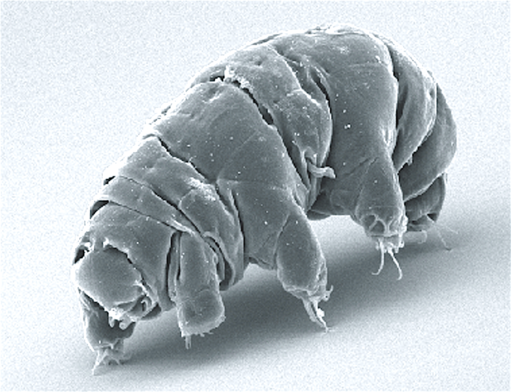SEM image of Milnesium tardigradum in active state by Schokraie E, Warnken U, Hotz-Wagenblatt A, Grohme MA, Hengherr S, et al. (2012) [CC BY 2.5]
The water bears, also known as Tardigrades, are Earth’s ultimate survivors. These tiny microscopic organisms have fascinated scientists for decades with their ability to survive in places such as polar regions, the depths of the sea and even space. But what makes the tardigrades so nearly-immortal? Why can they survive conditions that no other living thing can?
Read on to find out…
What makes a tardigrade so special?
Space water bears are tiny (up to 1.2 mm) microscopic organisms with eight limbs and a very unique ability to survive practically everywhere. From the depths of the ocean, to the top of the highest mountains, from the boiling hot springs, to the polar ice, tardigrades live almost everywhere on Earth. Some people will say that water bears are extraterrestrial creatures. However, this is not the case. The water bear surviving qualities are the result of their amazing ability to “dry up”!
Water bears are naturally water dwelling creatures but have evolved to be able to withstand living on land. They have learned to “dry up” (scientist call it desiccation) and live through very dry seasons on land. Water bears can literally shrink up, losing all but about 3% of their body’s water, and slow down their metabolism to an amazing 0.01% of their standard rate.
In this state the water bear will do nothing until the water is available again. When they are finally rehydrated, days, months or even decades later, the water bears come back to life as if nothing happened!
Tardigrades in space
To test the extend of the water bears supernatural surviving abilities, scientists decided to send some tardigrades into space. In September 2007, Swedish and German scientists launched a pack of space water bears into the Earth’s orbit for a 10 day space journey!
The experiment
The space bears were first dried out and then packed into small metal chambers. Some of these chambers had Sun protection to block the deadly solar radiation, but some didn’t. The chambers where then put into a lab container the size of a large shoe box and blasted into space. When the spacecraft reached its orbit, the container was left open for 10 days and the water bears were exposed to open space environment. After that they were returned back to Earth so that the scientists could observe the water bears and see if any damage was done to them.
(By the way this is what will happen to you and me if we go into space without a space suit)!
The results
The scientists noticed that the tardigrades protected from solar radiation were completely fine and not at all affected by the vacuum of space. They carried on with their lives as though they had never even left Earth. However, very few of the space water bears exposed to the suns rays managed to survive their mission. The radiation was just too much for them to handle! Anyway, with 68% of astronaut water bears still alive, the scientists called the experiment a huge success!
Cool facts about tardigrades
- They are sometimes called moss piglets as they love to live on moss and in wet places.
- Tardigrades eat juices of plants and bacteria, but some species can eat smaller water bears.
- The water bears will probably survive any catastrophic mass-extinction event and might well be the last creatures to live on Earth. Now, that’s comforting!
Still curious?
- If you want to find out more about the water bears, please send your questions and comments to the animal club team.
- If you want to learn more about less exotic but totally fascinating and easy to see with unaided eye animals, visit one of our animals animal handling sessions.
- Check out our other animal blog posts.



